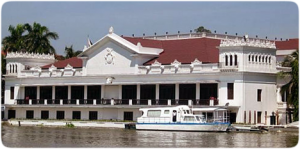Philippine Government
The Philippines is a democratic republic governed under a 1987 Philippine government constitution. This constitution is modelled on the commonwealth constitution of 1935 that set up a system of government similar to that of the United States.
It includes many restrictions on term lengths and presidential powers as a way to safeguard against authoritarian rule. All Philippine citizens age 18 or older may vote.
During the Marcos regime, the military was politicized and used to sustain his power. This set a precedent of military influence that has continued to be a destabilizing factor in Philippine government and politics.
 Philippine Government - Malacanang Palace |
Executive
The head of state and chief executive of the Philippines is a president, elected by popular vote to a non-renewable six-year term. The vice president, who is also directly elected, may serve no more than two consecutive six-year terms. The president and vice president are elected by separate ballot and may belong to different political parties. The president nominates appointments for heads of government departments, or ministries, to form a cabinet. The Commission on Appointments, composed of 24 members of Congress, reviews and votes on the nominations. The approved cabinet oversees the day-to-day functions of government. The president has limited emergency powers and may place the republic under martial law for no more than 60 days.
Legislature
The Philippine government has a bicameral (two-chamber) legislature called the Congress of the Philippines. The upper house, or Senate, has 24 members who are directly elected to serve six-year terms. Senators are limited to two consecutive terms. The lower house, or House of Representatives, has a maximum of 260 members who serve three-year terms; 208 representatives are directly elected and 52 are indirectly elected from party-list nominees of indigenous minority groups. House members are limited to three consecutive terms. A two-thirds vote of Congress is required to overrule a presidential veto of proposed legislation.
Judiciary
The highest tribunal in the Philippine government is the Supreme Court, made up of a chief justice and 14 associate justices, all appointed by the country’s president. The mandatory retirement age for Supreme Court justices is 70. Other judicial bodies include a court of appeals, courts of the first instance, and municipal courts.
Local Government
For administrative purposes the Philippine government is divided into regions, provinces, and chartered cities. Regions include the National Capital Region, encompassing the Manila metropolitan area; the Cordillera Administrative Region, a semiautonomous region of upland tribal groups in northern Luzon; and the Autonomous Region of Muslim Mindanao (ARMM), encompassing four provinces in Mindanao. The ARMM is a quasi self-governing region that was formed in 1989. It has an elected legislative assembly and is headed by a governor with limited executive powers. Provinces are headed by governors, and chartered cities are headed by mayors.
Philippine provinces are subdivided into cities and municipalities. Unlike chartered cities, which are accountable to the national government, cities and municipalities are responsible to the government of the surrounding province. Each provincial city or municipality is headed by an elected mayor.
The smallest unit of local Philippine government is the barangay. In rural areas the barangay is a village, and in urban areas it is a neighborhood. Each city or municipality contains numerous barangays, and there are thousands of barangays in the Philippines. Each barangay is administered by a chief executive and a community council, whose members are elected by the residents of the barangay.
Political Parties
Political parties in the Philippines are extensions of the key politicians who control them, rather than institutions focused on particular ideologies or political viewpoints. Political loyalties are given to individuals, and rarely to the parties. Politicians often switch party allegiances for personal gain or regional advantage.
Defense
In 2008 the armed forces of the Philippines included an army of 66,000 members, a navy of 24,000, and an air force of 16,000. Military service is voluntary. The Philippine National Police (PNP) is divided into regional units under a provincial commander.


